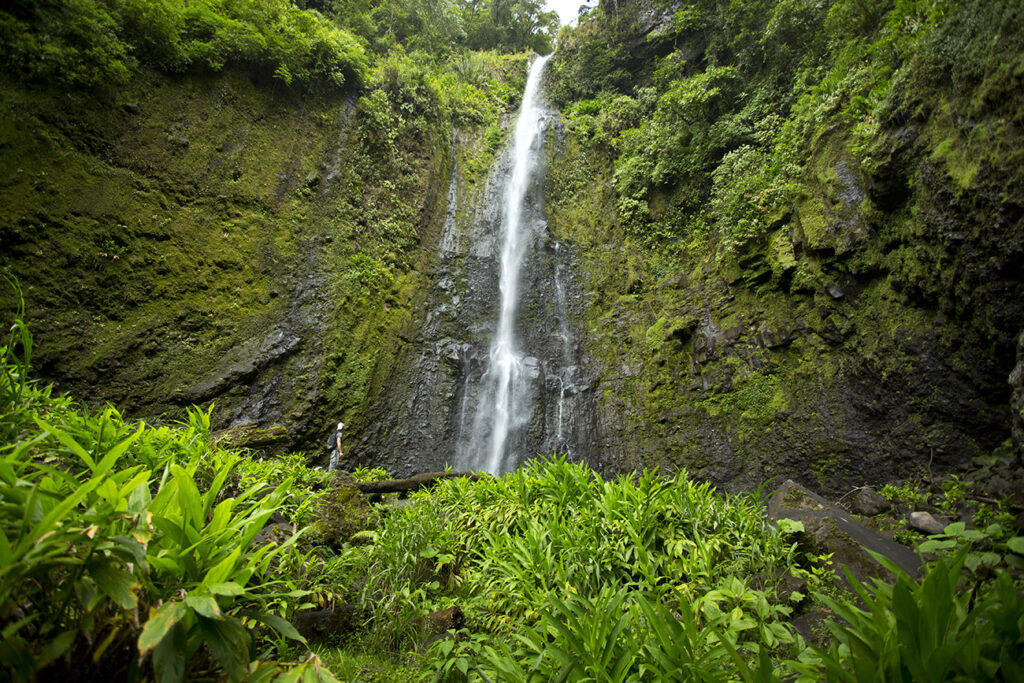Exploring the Jungles of Aquiares Estate: A Story of Carbon Neutrality

Spanning across 920 ha and reaching heights of 1,400 masl along the fertile slopes of the Turrialba Volcano sits Costa Rica’s largest and most historic coffee farm, Aquiares Estate. As the trees echo with sounds of toucan calls, the Estate tells a unique story, one of sustainability, carbon neutrality, and the future of coffee in Costa Rica.
Founded in 1890 by English businessmen, Aquiares became the one of the first farms to export Costa Rican coffee to European Countries. In the 1970s, the farm was acquired by the current owners, until finally in 1992, the Estate was under complete management of the Robelo family.
Aquiares translates to mean “land between rivers” in the indigenous language of Huetar. The vast stretches of trees within the Estate has become a hub for biodiversity, clean water, and protected forests. If you ever visit the wondrous area, you will surely stumble upon a collection of exotic birds, mammals, and numerous native tree species.
Not only is Aquiares a coffee farm and protected forest, but it is also a community, home to nearly 2,000 people. Jobs, resources, land, and services are provided to the community members by Aquiares; the farm reaps the benefit of having high-skilled workers right in the middle of all the coffee.
As the year 2000 rolled around, more shade trees populated the farm. This not only helped improve the connectivity between protected neighboring forests, but also lent support to improving the quality of the coffee. The shade trees were able to create a microclimate, promoting a slower development of the coffee cherry. There are over 100 different species of shade trees utilized in Aquiares including Poró, Laurel, and Cedar. In the past decade, the farm has planted well over 50,000 shade trees.

This had a significant impact on biodiversity; as more habitats were created and protected, Aquiares saw the emergence of new species. In 2003, studies conducted catalogued 30 species of birds. In 2020, there were over 142 species identified over a three-day study. Not only that, but new mammals are starting to venture into the Estate including ocelots and sloths. The presence of bird and other mammal species can actually provide natural benefits to the farm including the spread of native seeds and natural pest control.
In 2013, General Manager Diego Robelo sought to understand the farm’s carbon footprint. After a careful and strenuous process, Diego discovered that the farm released nearly 1,042 tons of CO2 into the atmosphere each year. This number was based on fuel, energy, fertilizer, and other resource use. Diego then strove to reduce this number and yearned to become carbon neutral by storing carbon from the atmosphere into shade-tree biomass. After another careful set of tests occurring over a year to understand his trees’ relationship with carbon and storage of carbon, results indicated that Aquiares was actually storing 3,790 tons of CO2, making the 920 ha of coffee trees and native vegetation, not only carbon neutral, but carbon negative.
In order to continue reducing Aquiares’ carbon footprint, new and more efficient tractors and machinery were purchased, organic fertilizer made from coffee pulp was distributed beneath the coffee trees, and methane emissions were reduced by turning the piles of coffee pulp to reduce the fermentation and release of greenhouse gases.
Costs have increased, yet there is no way to place a price tag on the long-term benefits of these sustainability goals. Aquiares is restoring forests and habitats whilst also purifying water sources and air quality. By removing CO2 from the atmosphere with the 200 ha of forest and 670 ha of coffee interlaced with shade, – the farm is able to offset its emissions and then some.

The agricultural sector in Costa Rica alone accounts for 37% of the greenhouse gas emissions each year, with 25% belonging to the coffee sector. By working with the NAMA Café group, Aquiares is lending support to the country’s project. The project has a number of initiatives including working to reduce nitrous oxide emissions with the adoption of more sustainable fertilizer, reducing methane emissions by improving water management, aerobic treatments of pulp, adoption of solar drying, and increasing coffee agroforestry systems to fix carbon.
La Roya, or Coffee Leaf Rust, began to take its toll within Aquiares in 2013. This meant that yields and quality decreased whilst production costs increased. La Roya is caused by the increase in temperature and moisture within coffee farms and leads to defoliation of the coffee tree. To prevent the spread, some producers have begun to intensely rely on fungicides. This is unsustainable and harmful to surrounding ecosystems and significantly increases the carbon footprint of the user. That is why producers similar to Diego, are turning to new varieties that are resistant to La Roya and are able to maintain yield and quality. Aquiares is currently in a transition, whereby the Caturra and Catimor are being phased out, with new hybrids such as Esperanza and Centroamericano to battle La Roya.
As countries begin working on new Climate Change policies and goals, Aquiares believes the coffee industry can play an important role in reducing emissions whilst also motivating other actors within the supply chain to make similar changes. During a recent visit to Costa Rica, COP 26 President Mr. Alok Sharma ventured to Aquiares along with Costa Rican president, Carlos Alvarado, to visualize and understand the Estate’s climate neutral model. Aquiares could act as a model for other farms to follow in order to reduce emissions; thus creating a future for coffee and the beautiful Costa Rican jungles.

March 2021 visit from COP26 President Alok Sharma, and Costa Rican president, Carlos Alvarado,Turrialba. Photo Credit: Roberto Carlos Sánchez
Aquiares has worked with Mercanta since 2016, and coffees will be available to purchase in the UK, Dubai, and Hamburg to arrive from June 2021 onwards.